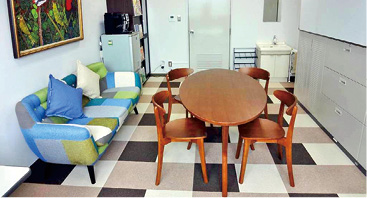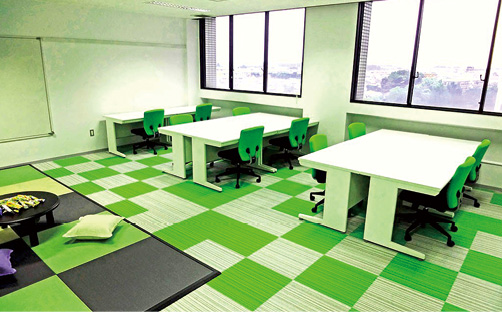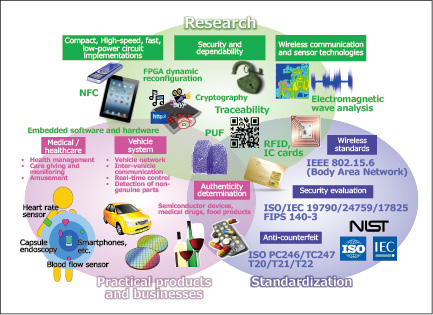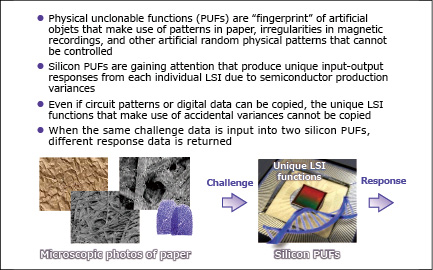
As of August, 2015
| Faculty/Department | Department of Communication Engineering and Informatics Graduate School of Informatics and Engineering |

|
| Members | Akashi Satoh, Professor | |
| Affiliations | Department of Communication Engineering and Informatics, Graduate School of Informatics and Engineering | |
Hardware, Security, Cryptography, PUF, Internet of Things (IoT), Machine-to-machine (M2M), Traceability, RFID, Embedded, Healthcare, Sensor networks, Agriculture
The words disorganized and chaotic apply to more than a few laboratories (student quarters and experiment rooms) at science and engineering universities. On desks are sprawled monitors, keyboards, mice, notes, copies of reference materials, magazines, toys, and snacks. Whiteboards are buried in scrawled notes and post-it notes, and the floor is littered with experimental apparatus and crawling with cords that threaten to trip the unsuspecting.
Faculty members are not outdone by their students in messiness. It is not uncommon to find faculty member offices with shelves already packed to bursting with publications and journals and bundles of documents, posing like skyscrapers, stacked precariously on the floor and desks.
Even if they are not this bad, all the laboratories I’ve visited have been, to some degree, chaotic. The exceptions are the well-organized, neat and tidy offices of female faculty members.
Although the director of the Satoh laboratory, Professor Akashi Satoh, is male, his laboratory is completely different, both from the trim offices of female faculty members and the tumultuous offices of male faculty members. After removing my outdoor shoes and stepping into the room, it suddenly reminded me of an office in an upstart IT venture (see Figure 1).

You are greeted by a lounge / reception area with a wooden table and chairs and a thick carpet on the floor. Along the wall is a colorful sofa with colorful cushions that invite you to relax. Beside the sofa is a refrigerator with a coffee maker placed on top.
I sit in a chair and survey my surroundings while drinking a coffee brewed by Professor Satoh. A painting decorates the wall in front of me. The only thing on the work desk to my left is a notebook computer. No accessories or objects like you might see on a female faculty member’s desk are to be found. Everything is wonderfully neat and clear cut.
Professor Satoh started his appointment at the university in April 2013, and the laboratory will start accepting students in April 2014. Arrangements were still being made in preparation to accept students at the time of this interview (December 2013), but already a number of third-year students had visited the laboratory to play (study?).
Professor Satoh pays close attention to two things to promote himself to prospective students. First, his lessons. He incorporates puzzles and magic tricks that fit the theme of his lectures and he includes plenty of stories from current events and digressions to hold his students’ interest. Second, the cozy atmosphere of his laboratory. His office creates a lavish ambience in which the professor and students drink coffee, relax on the sofa, and engage in deep discussions.
The students’ room contains a light-green-themed carpet and chairs and includes a separate space for sitting and relaxing (see Figure 2). Students can easily switch from on (facing their desks) to off (sitting and relaxing). The professor did much of the remodeling design and work as well, instead of leaving it up to contractors.

Professor Satoh says he wants to nurture leaders through the laboratory’s activities, which will begin at the start of the 2014 school year. Although Japan has many excellent researchers, there are extremely few leaders who can deftly head a research team and promote its results to the world. At the very outset, only one person in twenty has the qualities to be a leader.
And when plugging one’s research, appearances are nearly as important as the content of the research itself. For Professor Satoh, excellent research is not spontaneously recognized by the world; rather, excellent research only has value precisely because it is widely known. Furthermore, what grabs the interest of most people who are not experts (and this includes undergraduates) is, first and foremost, appearances.
Making ideas visible is stressed in business. In research too, the value of research results can be conveyed more easily by making the results visible, instead of just relying on equations and numbers. Adding a professional appearance to individual research results is important in forging a clearly focused image of the laboratory to the outside world. In this sense, the interior design of the rooms plays a role in promoting the laboratory to undergraduates who are not yet experts.
The professor also explains the importance of easing up in order to produce more results. One hundred percent completion is almost never achievable. So if you can reach 80 percent completion in one direction with 50 percent of your total energy, instead of using up 100 percent of your energy aiming for a near-impossible 100 percent completion in one area, use the remaining 50 percent of your energy to achieve another 80-percent result somewhere else. This way, you will get a total of 160-percent results from 100 percent of your energy. Researchers tend to obsess on one thing. But to maximize the overall results given limited resources, it is necessary to cut corners at the right moments: in other words, deciding what not to do instead of deciding what to do. Otherwise, you will spend 100 percent of your energy doing too many things, and your performance and efficiency will suffer.

Starting in April 2014, Professor Satoh plans to direct the laboratory’s hardware research in three main areas: compact, high-speed, low-power circuit implementations; security and dependability; and wireless communication and sensor technologies (see Figure 3).
After completing a Master’s course at a graduate school in 1989, Professor Satoh produced remarkable results in his research into security and high-reliability technology for hardware at IBM Japan and the National Institute of Advanced Industrial Science and Technology.

Technology to distinguish between genuine articles and forgeries - i.e., technology to detect imitations - is expected to become increasing vital in the security field. Fingerprints, because they are unique to individuals, are used by banks and other institutions for personal authentication. Artificial hardware objects also have unique information, generated from physical variances that cannot be duplicated. Attention is focusing on research into a technology called physical unclonable function (PUF) that makes use of this unique information, which is like a fingerprint of artificial object. Researchers are working toward practical implementations of this technology to fight against counterfeiting (see Figure 4).
At the same time, IoT (Internet of Things) or M2M (machine-to-machine) world are forming, in which things connect to networks and exchange information without any human. Things, in this context, range from information devices, electrical appliances, and cars to all kinds of sensor devices. Here, again, authentication technologies and security technologies using PUFs will be critical.
As for future research directions, Professor Satoh mentioned that he has an interest in agriculture. He thinks it is possible to raise high-value-added fruits and vegitables on the tops of urban buildings by creating numerical models and algorithms from cultivation know-how and pairing these models and algorithms with sensor technology. In addition to the benefit of having real, harvestable results, this research will provide countermeasure against urban heat island . Although his research to date has focused on hardware, Professor Satoh is seeking forward-thinking joint research projects with companies in the areas of software, which control hardware, and even the service business for end customers. He is open to any research topic, as long as it is interesting.
Professor Satoh’s underlying philosophy is that (for the university) students are customers. He is inspired by the thought of what can be done for the students. His big dream is to create an university that attracts the best and brightest students and nurtures students with leadership qualities, who will pull along other students (and instructors too) while developing, through competition and cooperation, with the outside world.
[Interview and article by Akira Fukuda (PR Center)]